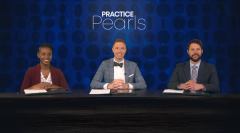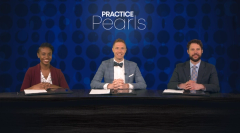
Requirements for URAC Reaccreditation
The pharmacist panel highlights valuable efforts to achieve URAC reaccreditation.
Episodes in this series

Sharita Howe, PharmD: One other thing: I’ve started reading this book called “Atomic Habits,” and one of the things that they mention in this book is that to form a habit, a lot of times we start from the outside and work our way in. What we start with is a goal. Let’s say you’re playing a sport. With anyone who’s playing a sport, their goal is to win. When you play basketball, everybody wants to win, but there are some winners and some losers.
If you’re focusing on the goal but you’re not forming these systems, then you may not reach your goal. But if you form the systems, you’re always going to reach goals that you may not know you even had. When we’re looking at these patients with MPNs [myeloproliferative neoplasms], it’s important that we start, like you were saying, with these operational processes to make sure we’re capturing them at these different moments in time. That way if we develop these initiatives, we’ll always hit a goal, even though we may not know what that goal is at this time.
Ryan Haumschild, PharmD, MS, MBA: I love it. It’s the framework-for-success idea, which is important. I want to build off what you said and bring it back to URAC, a little more specifically. Jeff, because you have experience with URAC and have been seeing patients for a while in your practice and you’ve been part of that development, as you work with your team, we recognize you do a lot, but it’s a team-based approach to care. How do you work with your team to renew reaccreditation for URAC? How do you implement some of these quality initiatives you’re doing in clinic around MPNs? How do you wrap that back to URAC accreditation requirements, making sure that you’re staying competitive in your quality-of-care initiatives and they also align with your goals of accreditation?
Jeff A. Gilreath, PharmD: There are several questions there. In working with URAC, there’s a minimum standard that we have to meet in counseling our patients. In the clinic, I divide that responsibility with our retail dispensing pharmacists because I have face time with the patients. I have formed a relationship with them first, so I usually take the liberty to counsel the patient when we’re starting drug treatment, whether that be a pill or an injection.
I also invite patients back to my clinic to do subcutaneous injection teaching. I do that because it isn’t inherently obvious. You can’t simply send someone a syringe or a vial and expect them to do that successfully if they’ve never done a self-injection. Moreover, the concentrations change. On one product, it doesn’t actually have a gradation on the syringe down to a 45 mcg dose. How is the patient going to figure that out? Are they going to guess? They need hands-on teaching in the clinic to make that successful. I typically do that type of teaching for patients.
In terms of follow-up, that’s where our retail pharmacists typically come in. During the dispensing of the prescription for the next refill, they’ll assess for adverse effects. If the patient has any adverse effects from treatment or questions about their care in general, that pharmacist will relay that information back to us in the clinic and then I’ll discuss that with the hematologist and develop a plan.
In terms of staying competitive, we always have to challenge the status quo on how we care for these patients. It’s helpful to attend meetings such as ASH [American Society of Hematology] and now more so ASCO [American Society of Clinical Oncology], as they’re inviting more [presentations on] hematologic malignancies every year. The field is changing quickly. It’s evolving. Drugs are getting approved. There were 2 approved in the last year for MPN.
We have to stay up on the literature and in terms of staying competitive, if we can produce literature like Sharita was saying, this doesn’t have to be a randomized controlled trial to contribute to the body of evidence. There’s tremendous interest in patient-reported outcomes and real-world outcomes that if you’re seeing these patients, you can collect these data and identify challenges and report on the data. To stay competitive, you have to challenge the status quo and advance the field by keeping the patient as the centered focus and listening to them, identifying what they’re struggling with, and then addressing their needs.
Ryan Haumschild, PharmD, MS, MBA: Well said.
Transcripts edited for clarity.
Newsletter
Stay informed on drug updates, treatment guidelines, and pharmacy practice trends—subscribe to Pharmacy Times for weekly clinical insights.

















































































































































































































